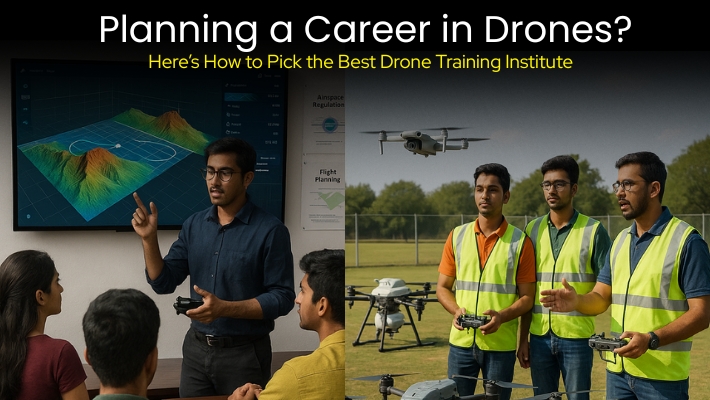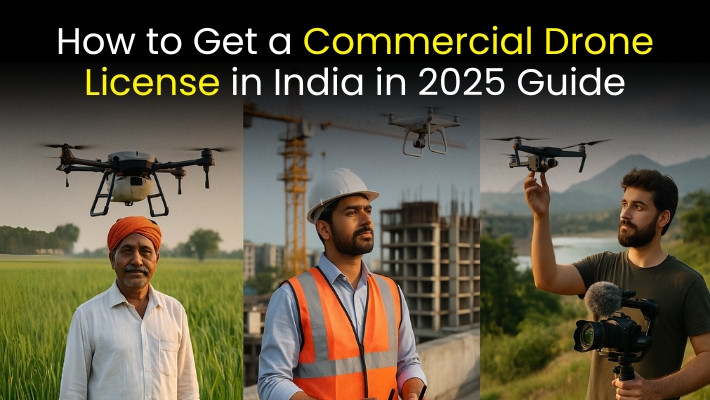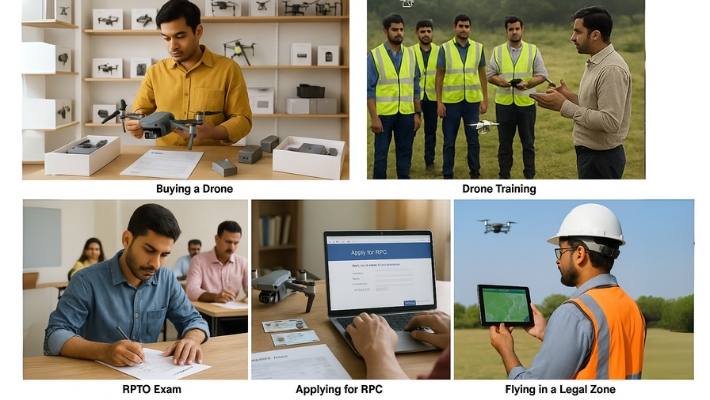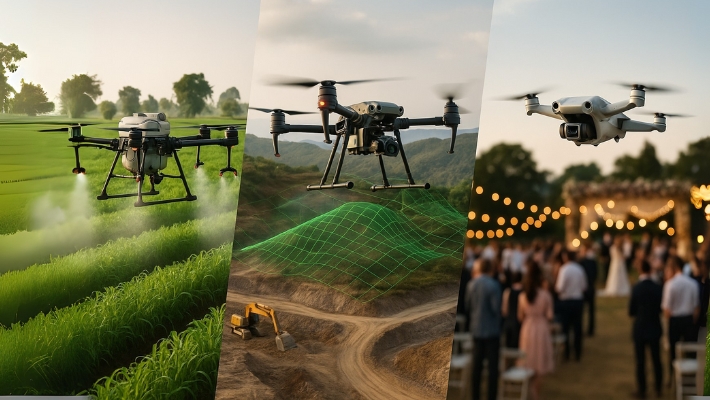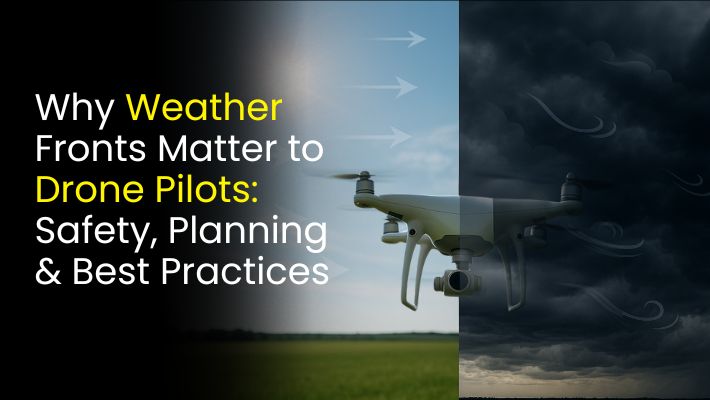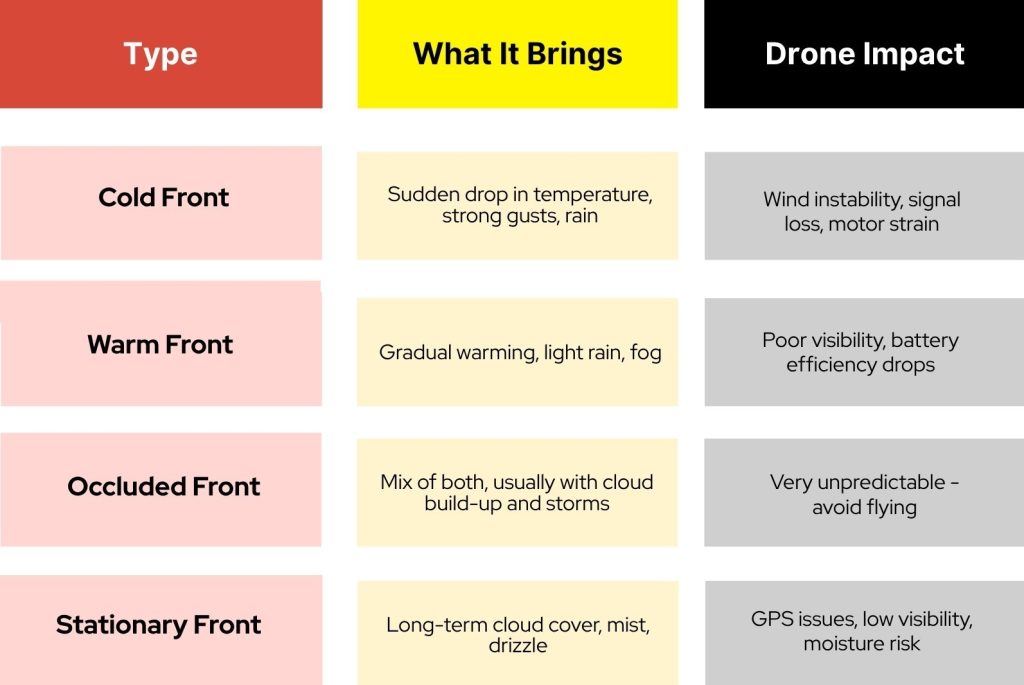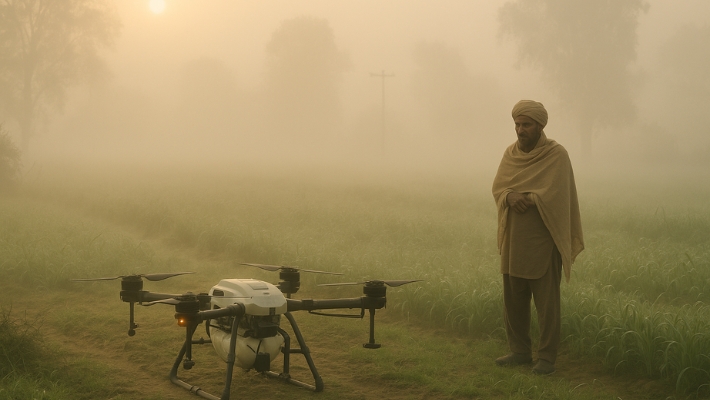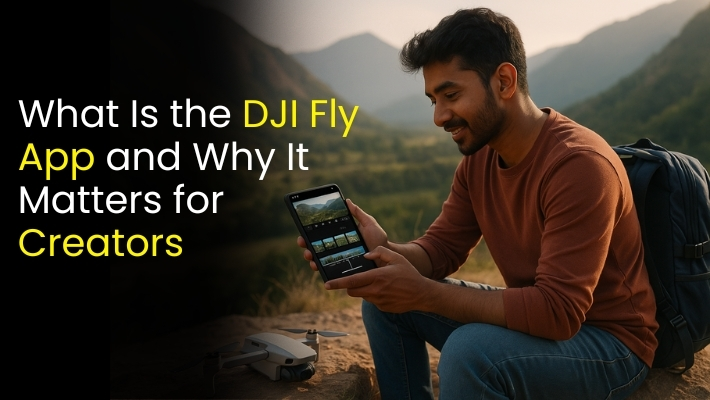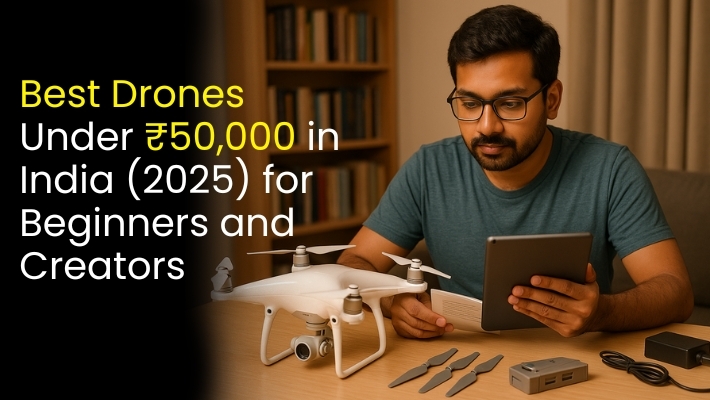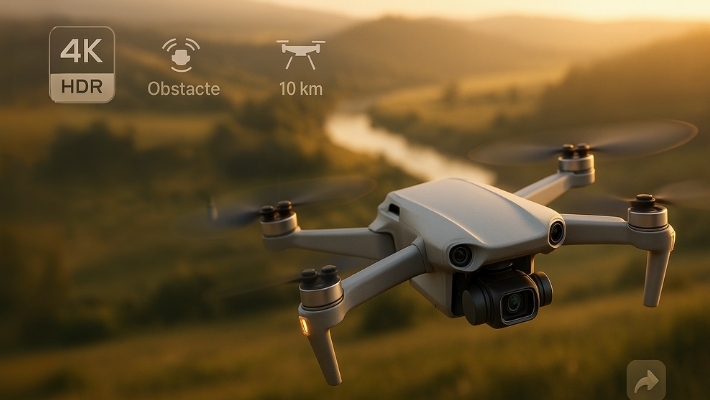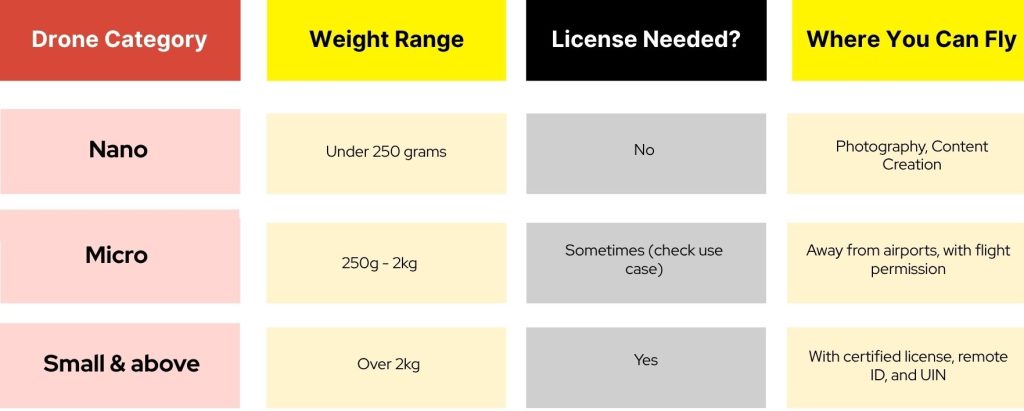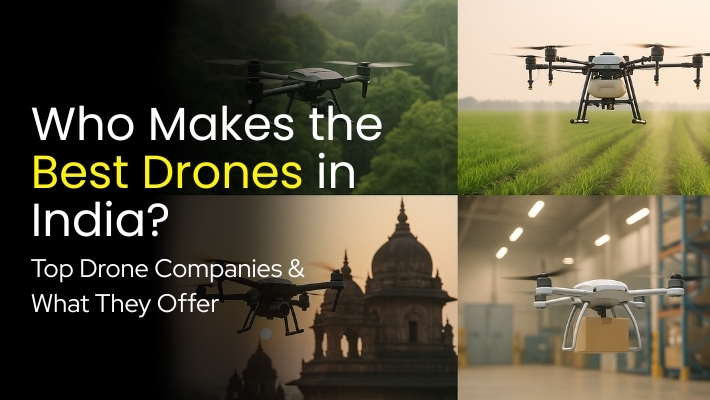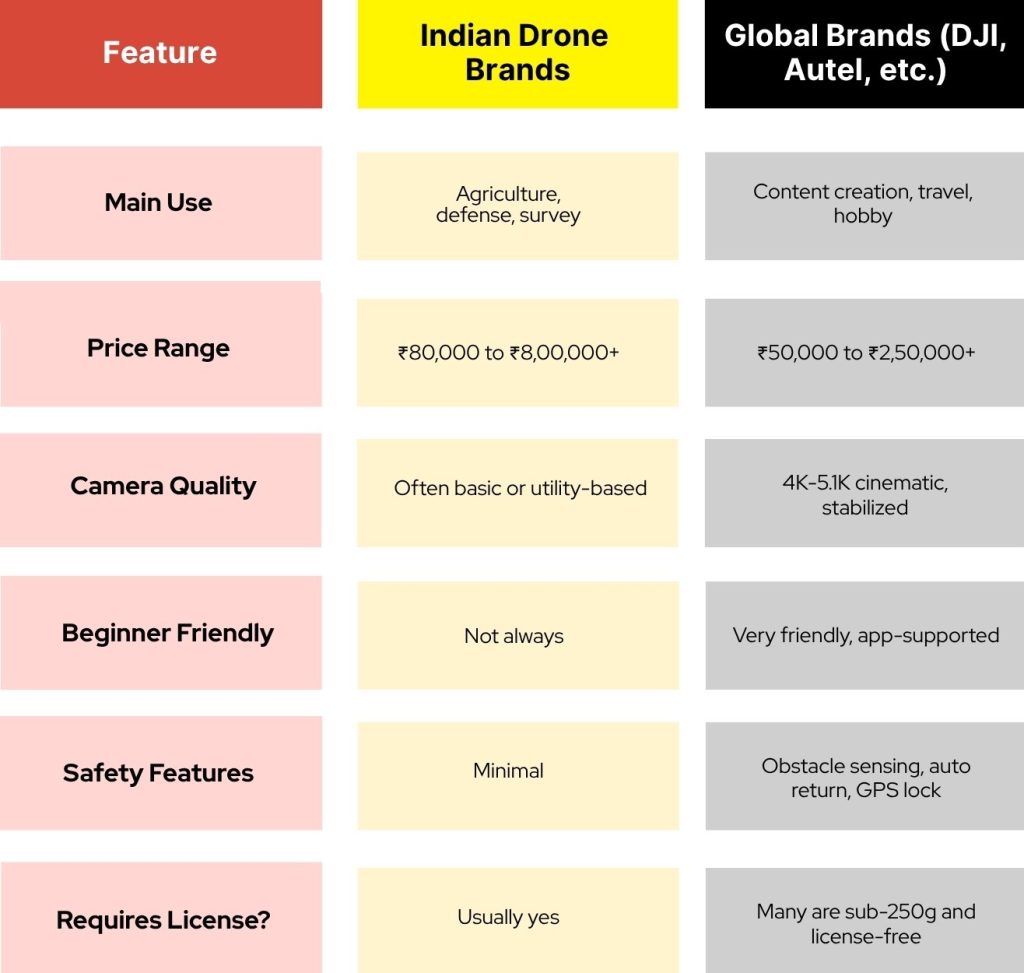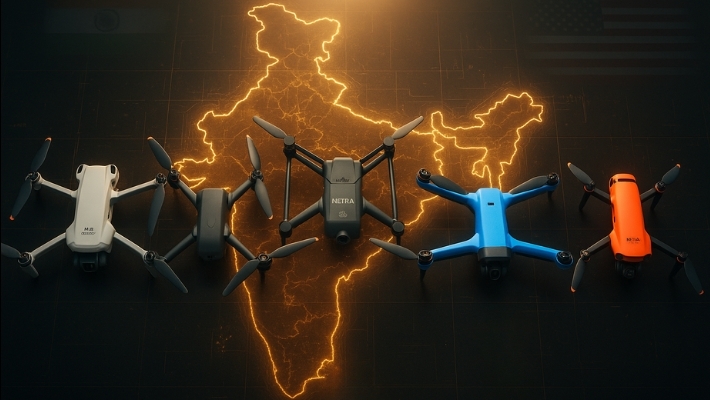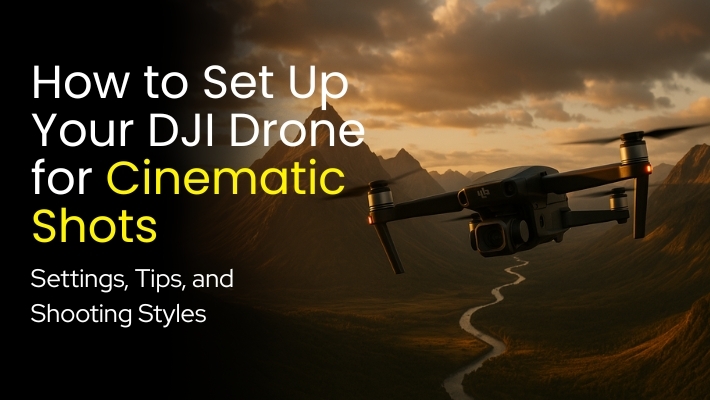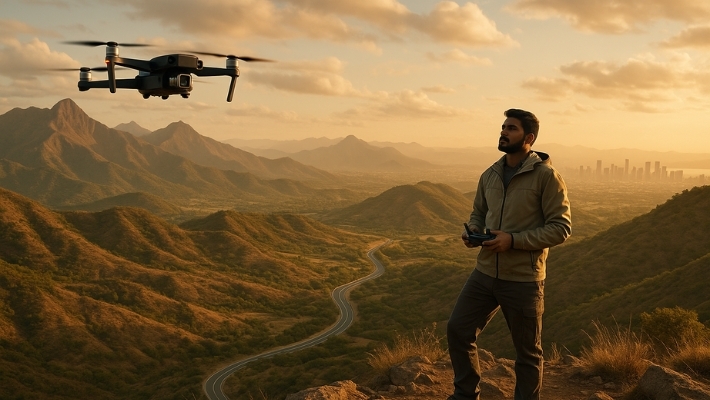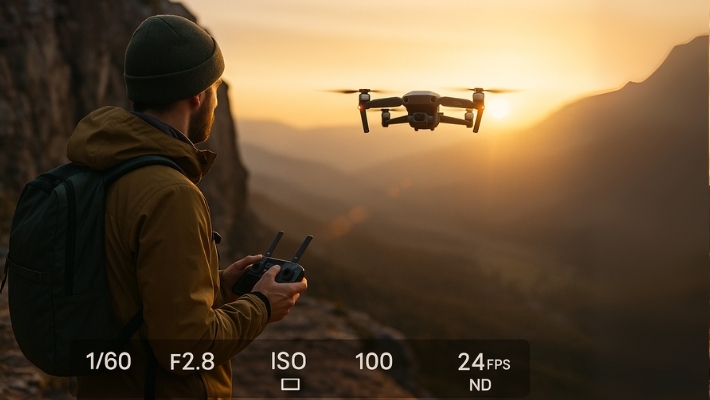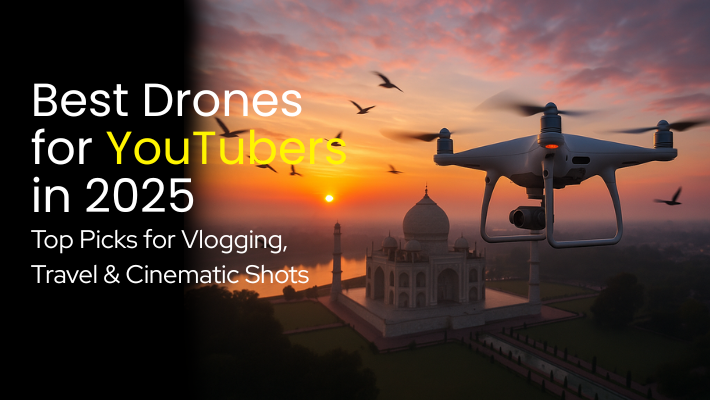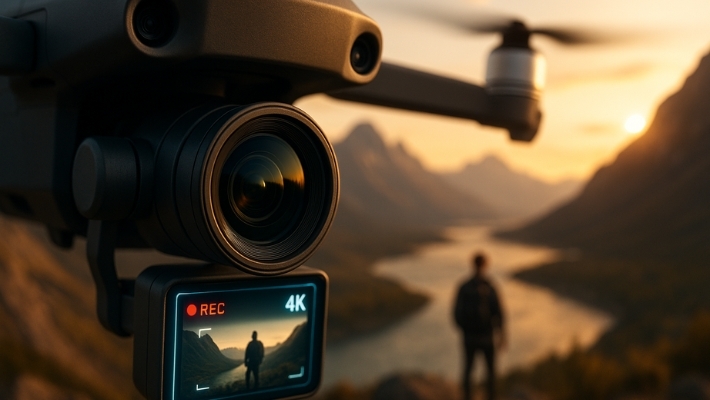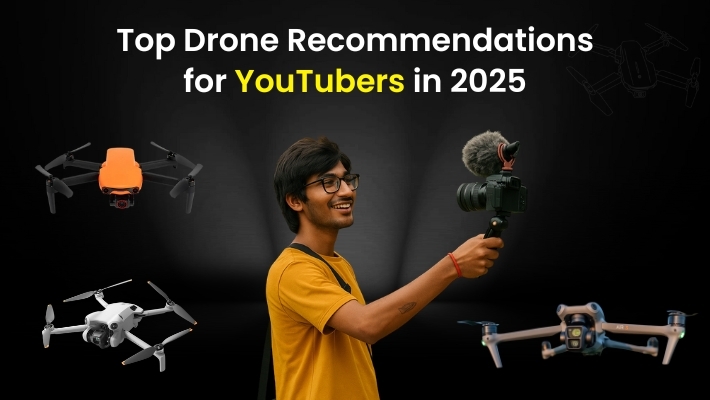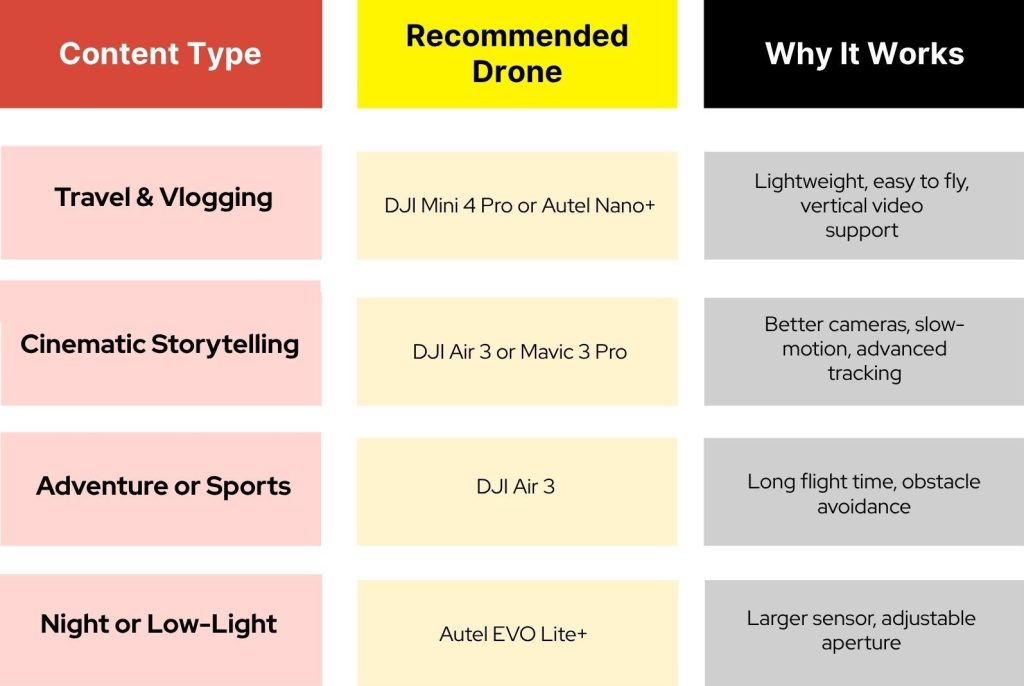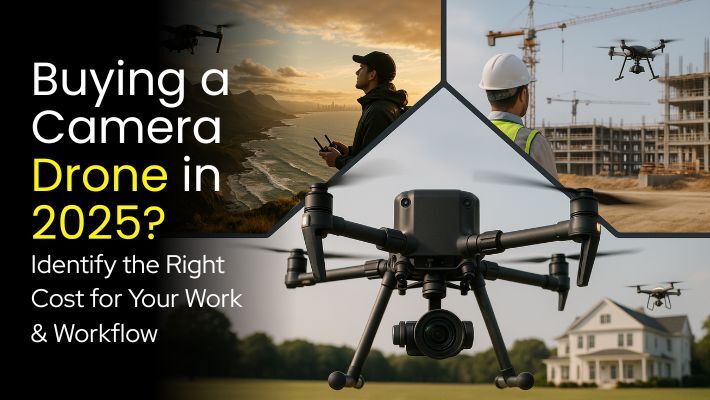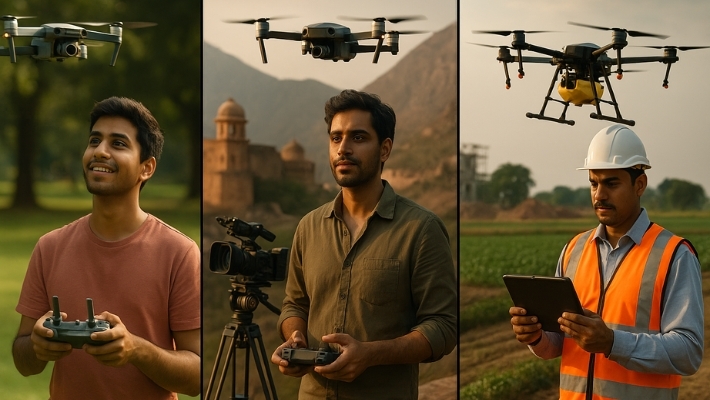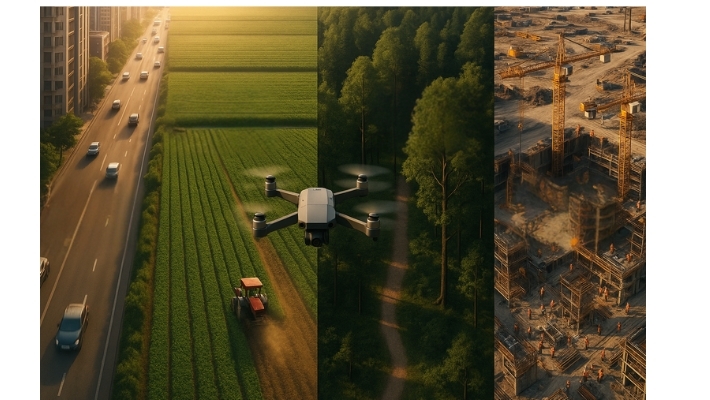Planning a Career in Drones? Here’s How to Pick the Best Drone Training Institute
The drone industry is booming and not just for hobbyists. From agriculture and surveillance to filmmaking and delivery, drones are opening up new career paths across multiple sectors. But if you’re serious about turning this technology into a profession, enrolling in a certified drone training institute is your first critical step.
Choosing the right drone school isn’t just about getting a certificate. It’s about building the right foundation technical skills, flight safety, industry exposure, and legal know-how. With so many institutes now offering drone pilot training, how do you decide which one is worth your time and investment?
In this guide, we’ll walk you through everything you need to know to choose the best drone training institute for your career. Whether you’re aiming to work with global brands like DJI, Autel, or India’s own Ideaforge, or looking to build a freelance or corporate career this article is for you.
Why Drone Training Matters More Than Ever in 2025
The demand for skilled drone professionals is at an all-time high. With industries like agriculture, construction, filmmaking, disaster management, and law enforcement rapidly adopting drone technology, the need for properly trained pilots has become a national priority.
But here’s the catch: owning a drone isn’t the same as knowing how to use it professionally. Buying a feature-packed model like the DJI Mini 4 Pro may make flying feel easy, but to work on commercial projects, you need far more than just equipment you need structured training and DGCA certification.
Why certification and structured training matter:
- Legal compliance: Not sure if you can fly your drone freely? Read [Can I Fly My Drone Freely or Do I Need a License?] for a full breakdown of legal requirements.
- Commercial viability: Whether you’re helping farmers with crop surveys or builders with site inspections, clients now prefer pilots with verified credentials.
- Safety first: Even drones with smart safety features like DJI’s obstacle sensors can crash in the hands of an untrained user. That’s why we wrote [Worried About Crashing Your First Drone? Here’s Why DJI’s Safety Features Have Your Back].
- Career edge: Hiring managers and government projects often shortlist only DGCA-certified drone operators.
Career areas where training helps you stand out:
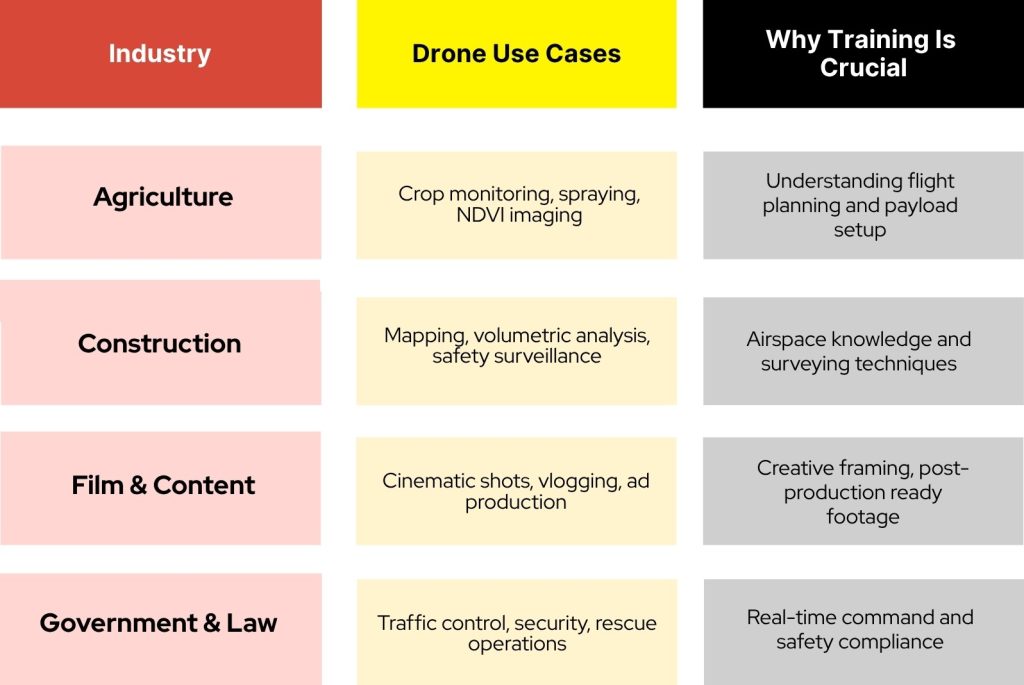
Even if you’re just starting your journey as a content creator, a solid foundation in drone handling makes a difference. Check out [Is Buying a Drone Enough to Start My Journey as a Content Creator?] to understand what it takes.
What to Look for in a Good Drone Training Institute
Not all drone training schools offer the same quality or outcomes. Some might just walk you through the basics and offer a certificate, while others provide hands-on learning with real-world scenarios, flight hours, and exposure to popular drone platforms like DJI, Autel, and Ideaforge.
Here’s how to separate a worthwhile drone academy from the rest.
1. DGCA Certification and Accreditation
Make sure the school is certified by the Directorate General of Civil Aviation (DGCA) in India. Only DGCA-authorized training organizations (DTOs) are allowed to issue pilot licenses valid for commercial drone operations.
Want to fly legally in India or plan to buy drones like the DJI Mini 4 Pro or Autel EVO II? You’ll need DGCA clearance for many operations. We’ve explained all of this in [Can I Fly My Drone Freely or Do I Need a License?].
2. Course Structure and Duration
A quality course should offer a balance of:
- Theory: Regulations, weather, airspace classification, drone technology
- Flight practice: Simulated flights, real drone hours
- Industry exposure: Use-case demos for agriculture, construction, cinematography, etc.
Look for programs with at least 3–5 days of intensive training, which should include real-time mission planning and post-processing basics.
3. Fleet Variety for Practice
A good institute won’t just teach you on one drone model. It should expose you to multiple platforms like:
- DJI Mini series (like in [DJI Mini 3 vs. Mini 4 Pro—Which Combo Is Right for You?])
- DJI Fly More Combo setups (covered in [What Is the DJI Fly More Combo?])
- Autel Robotics drones
- Ideaforge Q Series or NETRA (used in security and defense)
4. Trainer Credentials
Ask about the instructors:
- Are they certified?
- Do they have experience in commercial projects?
- Have they worked with government bodies or enterprises?
Trainers with field experience across sectors will offer far better insights than purely academic instructors.
5. Post-Course Support
Some institutes help you beyond the course by:
- Assisting with license applications
- Helping you get internships or freelance work
- Offering discounts on drone purchases via verified sellers like Jetayu Gadgets
Top Drone Training Institutes in India (2025 Update)
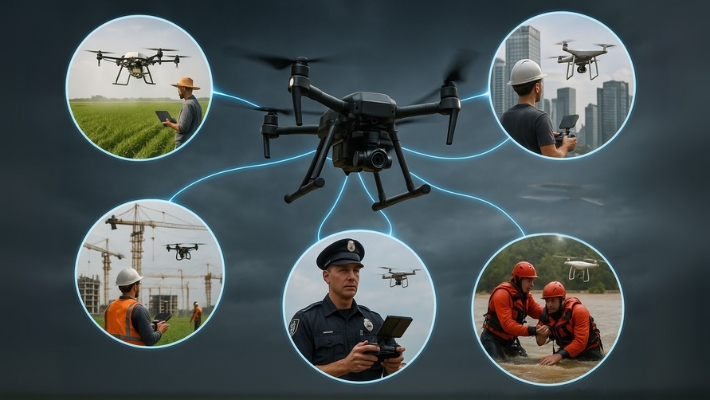
India’s drone ecosystem has grown rapidly, and so has the number of DGCA-authorized training centers. Whether you’re planning to work in agriculture, surveillance, filmmaking, or logistics, choosing a reputed institute will set the tone for your entire drone career.
Here are some of the top drone training academies to consider in 2025:
1. Indira Gandhi Institute of Aeronautics (IGIA) – Chandigarh
- DGCA-certified and known for high-quality training
- Offers courses on RPAS, drone safety, and mission planning
- Trains using DJI and Autel platforms
2. Indira Gandhi Institute of Aviation Technology (IGIAT) – Delhi NCR
- Focus on DGCA-certified remote pilot training
- Good for beginners planning a career in civil aviation or security
- Includes both theoretical and hands-on training
3. DroneAcharya Aerial Innovations – Pune
- One of the most industry-connected institutes in India
- Offers advanced training in GIS mapping, surveying, and agriculture drone operations
- Known for using Ideaforge and DJI drones in practical sessions
4. Droni Tech – Pan-India
- Offers specialized training in cinematography, inspection, and agriculture
- Frequently updates its curriculum with global trends
- Uses drones like DJI Mavic, Autel EVO, and DJI Mini series
5. Ranchi University Drone Centre – Jharkhand
- Government-affiliated, affordable training for rural and small-town youth
- Works on real-life missions, including forest monitoring and agriculture spraying
- Trains with public sector drones and indigenous models
Quick Comparison Table:
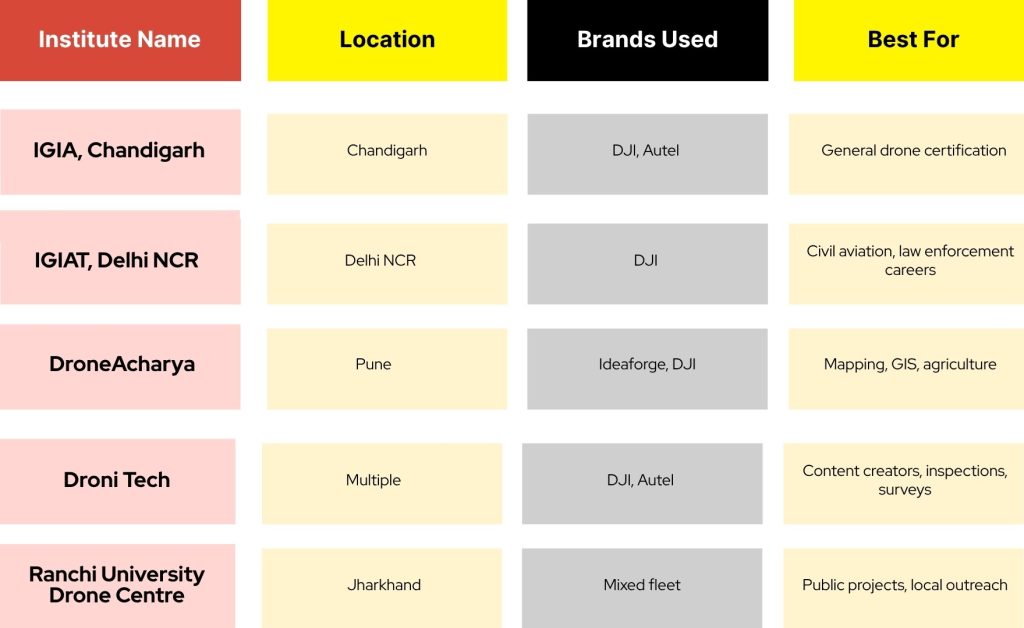
Even if you plan to rent drones instead of buying right away, as discussed in [Why More Creators and Surveyors Are Renting Drones Instead of Buying], these schools offer hands-on access to industry models to get started.
Mistakes to Avoid When Choosing a Drone School
Choosing the wrong drone training institute can cost you more than just money it can delay your career, limit your flying opportunities, and even lead to compliance issues. Here are the most common mistakes people make and how to avoid them.
1. Not Verifying DGCA Authorization
This is non-negotiable. If the school isn’t on the DGCA’s official list of authorized Drone Training Organizations (DTOs), their certificate won’t help you get licensed.
Need help understanding the license process? Read [Can I Fly My Drone Freely or Do I Need a License?].
2. Focusing Only on Cost
Low fees often mean low-quality training. If a course looks too cheap, check if it includes hands-on practice, modern drone models, safety training, and exam preparation.
3. Ignoring Brand and Model Exposure
Some institutes only teach theory or provide outdated drones for practice. A good course will expose you to the latest in DJI, Autel, and Ideaforge fleets—because these are the models used in actual projects.
Learn more about models like the DJI Mini 3 vs. Mini 4 Pro and what they offer for beginners and pros.
4. Skipping Reviews and Alumni Feedback
Don’t trust just the brochure. Search for alumni reviews on platforms like Quora, YouTube, or LinkedIn. You can even reach out to past students directly. Ask about:
- Trainer quality
- Industry connections
- Job assistance or placements
- Real drone flying time
5. Overlooking Post-Course Guidance
A good institute doesn’t leave you hanging after the training. Look for schools that:
- Guide you on drone registration and UIN application
- Offer discounts via sellers like Jetayu Gadgets if you’re ready to buy your first drone
- Connect you to internships, gigs, or government projects
And if you’re unsure about buying brand-new equipment right away, check out [New to Drones? Here’s Why Refurbished Is the Smartest Way to Start] and [Bought a Drone Recently? Here’s How to Verify If It’s Not Refurbished].
Career Opportunities After Completing Drone Training
Drone training isn’t just a certificate it’s a gateway to a growing number of high-paying and in-demand roles across India and globally. Once you’re certified, you can position yourself in a range of industries, either as a freelancer, a full-time employee, or even a drone entrepreneur.
Here’s where your drone training can take you:
1. Aerial Surveying and Mapping
- Used in: Real estate, urban planning, mining, infrastructure
- Tools used: DJI Mavic 3 Enterprise, Ideaforge Q Series
- Why it matters: Faster and more accurate data than traditional surveying
Related read: [Why Builders Now Trust Drones More Than Ground Teams for Site Surveys]
2. Agriculture Drone Operations
- Used in: Crop spraying, NDVI imaging, pest management
- Tools used: DJI Agras series, custom-built spray drones
- Your role: Pilot, field technician, agri-drone service provider
Explore more: [How Agriculture Drones Are Transforming Indian Farms: A Guide to the Top Models in 2025]
Also read: [Can Drones Solve India’s Labour Crisis in Agriculture?]
3. Cinematography and Content Creation
- Used in: Weddings, documentaries, music videos, YouTube
- Tools used: DJI Mini 4 Pro, Avata 2, Autel EVO Lite+
- Your role: Cinematic drone pilot, solo vlogger, drone videographer
Explore:
[Is Your Partner a Photographer or Videographer? Surprise Them With the Perfect Drone Gift]
[Vlogging Your Solo Adventure? Here’s What Only a Drone Can Film]
4. Security and Surveillance
- Used in: Traffic monitoring, event management, police operations
- Tools used: Ideaforge NETRA, DJI Mavic 3 Thermal
- Your role: Surveillance operator, remote pilot, drone analyst
See how it works:
[Gujarat Police Cleared to Launch High-Tech Drone Program for Safer Cities]
[Dogs on the Ground, Drones in the Sky: India’s New Crime-Fighting Duo]
5. Humanitarian and Emergency Services
- Used in: Disaster management, search & rescue, flood monitoring
- Your role: Drone responder, UAV mission planner, NGO partner
Relevant posts:
[Drones Could Be Heroes in the Northeast’s Flood and Landslide Crisis]
[The Fastest Blood Delivery in the World? A Drone in the Sky]
Bonus: Make Money Without a Job
Already trained and licensed? You can also:
- Rent out drones ([Why More Creators and Surveyors Are Renting Drones Instead of Buying])
- Sell used models ([Upgrade Time? Sell Your Old Drone with Just a Few Clicks])
- Start a drone repair service ([From Cracked to Crafty: Repair Your Drone, Fly Like It’s Day One])
Frequently Asked Questions (FAQs)
1. Do I really need a license to fly a drone in India?
Yes, for most commercial operations and drones above 250 grams, you need a DGCA-approved drone license. This is why enrolling in a certified drone training institute is essential.
2. What kind of drones will I learn to fly during training?
Most good drone schools offer hands-on training on popular models like the DJI Mini series, Autel EVO, and even Ideaforge platforms for industrial use.
3. Can I become a YouTuber or content creator after drone training?
Absolutely. Drone training helps you master aerial camera handling, which is a game-changer for vlogging, travel, or filmmaking.
4. How do I know if a drone school is certified?
Visit the DGCA’s official website and look for their updated list of Drone Training Organizations (DTOs). Don’t just rely on claims made on a school’s website. This avoids the mistake of joining a non-recognized course, as discussed earlier.
5. What if I don’t want to buy a drone right away after training?
That’s totally fine. Many trained professionals either rent drones or work for firms that provide the equipment.

